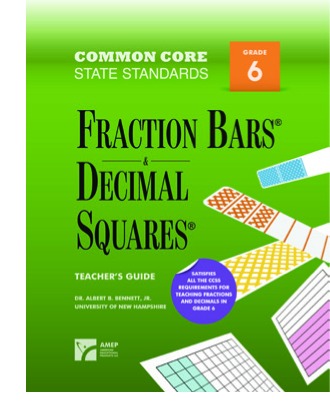Home
Grade 6 Common Core State Standards
for Fraction and Decimals |

Apply and extend previous understandings of multiplication and division to divide fractions by fractions.
6.NS.1. Interpret and compute quotients of fractions, and solve word problems involving division of fractions by fractions, e.g., by using visual fraction models and equations to represent the problem. For example, create a story context for (2/3) ÷ (3/4) and use a visual fraction model to show the quotient; use the relationship between multiplication and division to explain that (2/3) ÷ (3/4) = 8/9 because 3/4 of 8/9 is 2/3. (In general, (a/b) ÷ (c/d) = ad/bc.) How much chocolate will each person get if 3 people share 1/2 lb of chocolate equally? How many 3/4-cup servings are in 2/3 of a cup of yogurt? How wide is a rectangular strip of land with length 3/4 mi and area 1/2 square mi? Compute fluently with multi-digit numbers and find common factors and multiples.
Note: The preceding lesson has four examples of a fraction divided by a fraction that are illustrated using visual fraction models and which extend the whole number concept of division (determining the relative size of two amounts) to divsion of fractions. These quotients provide patterns for discovering the "invert and multiply" approach. Further illustrations of division showing solutions to word problems can be seen in Division Step 1 TeachingFractionBarsVideos, and this video also has fraction models illustrating division of fractions by getting common denominators.
- Lesson: Dividing by Fractions and Mixed Numbers
- Worksheet #3
- Worksheet #4
Note: The preceding lesson has visual illustrations of fractions divided by fractions and mixed numbers divided by fractions. The common misconception that "division makes smaller" is illustrated in this lesson as well as in Division Step 2 TeachingFractionBarsVideos.
- Lesson: Word Problems Involving Division of Fractions and Mixed Numbers
- Worksheet #5
- Worksheet #6
Note: The preceding lesson has word problems involving division of fractions, mixed numbers, and whole numbers, as well as word problems involving ratios.
- Lesson: Missing Dimensions of Rectangles with Fractional Side Lengths
Note: The preceding lesson reviews the Grade 5 Lesson "Finding Areas of Rectangles with Fractional Side Lengths" and has examples of finding the missing dimension of a rectangle when the area and one dimension are given.
Compute fluently with multi-digit numbers
6.NS.3. Fluently add, subtract, multiply, and divide multi-digit decimals using the standard algorithm for each operation.
- Lesson: Addition of Decimals with Same Number of Decimal Places
- Worksheet #1
- Worksheet #2
- Lesson: Addition of Mixed Decimals
- Worksheet #5
- Worksheet #6
- Worksheet #7
Note: Worksheet #3 has a sheet of Blank Decimal Squares attached for illustrating a few of the sums. Worksheet #7 has word problems involving addition of decimals and mixed decimals. Visual illustrations of the operations in these three lessons can be seen in TeachingFractionBarsVideos in Addition Step 1, Addition Step 2, and Addition Step 3.
- Lesson: Subtraction of Decimals with Same Number of Decimal Places
- Worksheet #8
- Worksheet #9
- Worksheet #10
- Lesson: Subtraction of Decimals with Different Numbers of Decimal Places
- Worksheet #11
- Worksheet #12
- Lesson: Subtraction of Mixed Decimals
- Worksheet #13
- Worksheet #14
- Worksheet #15
Note: Worksheets #8 and #11 each have a sheet of Blank Decimal Squares attached for illustrating differences involving decimals and mixed decimals. On worksheets #10 and #13, each exercise for computing a difference also asks for a corresponding approximation that involves rounding to the nearest tenth or nearest whole number. Worksheet #15 has word problems involving differences of decimals and mixed decimals. Visual illustrations of the operations in these three lessons can be seen in TeachingFractionBarsVideos in Subtraction Step 1, Subtraction Step 2, and Subtraction Step 3.
- Lesson: Multiplication of Decimals by Whole Numbers
- Worksheet #16
- Worksheet #17
- Worksheet #18
- Lesson: Multiplication with Mixed Decimals
- Worksheet #22
- Worksheet #23
- Worksheet #24
Note: Worksheet #18 has a sheet of Blank Decimal Squares attached for illustrating products involving decimals. On worksheet #22, there are exercises for approximating products by rounding mixed decimals to the nearest whole numbers. Worksheet #24 has word problems involving products of decimals and mixed decimals. Visual illustrations of the operations in these three lessons can be seen in TeachingFractionBarsVideos in Multiplication Step 1, Multiplication Step 2, and Multiplication Step 3.
- Lesson: Division of Decimals by Whole Numbers
- Worksheet #25
- Worksheet #26
- Lesson: Division by Mixed Decimals
- Worksheet #30
- Worksheet #31
- Worksheet #32
Note: Worksheets #26 and #27 each have a sheet of Blank Decimal Squares attached for illustrating quotients involving decimals. Worksheet #29 has quotients that are repeating decimals. Worksheet #32 has word problems involving quotients of decimals and mixed decimals. Visual illustrations of the operations in these three lessons can be seen in TeachingFractionBarsVideos in Division Step 1, Division Step 2, and Division Step 3.
|
| |
| |
| |
Please direct questions and comments about this page to abbj@.unh.edu
© Copyright 2001-2012, Albert Bradley Bennett, Jr.










